Model Reference Adaptive Control and Fuzzy Neural Network Synchronous Motion Compensator for Gantry Robots
Abstract
:1. Introduction
2. The Structure and Mathematical Model of the Gantry Robot System
3. Proposed Control System
3.1. Controller Design for The Single Sxis
3.2. FNN Synchronous Motion Compensator
Layer 1: Input layer
Layer 2: Linguistic layer (Membership layer)
Layer 3: Rule layer
Layer 4: Output layer
3.3. On-Line Learning Algorithm
3.4. Stability Analysis
4. Experimental Results
4.1. Parallel Synchronous Control
4.2. Parallel Master–Slave Synchronous Control
5. Conclusions
Author Contributions
Funding
Institutional Review Board Statement
Informed Consent Statement
Data Availability Statement
Conflicts of Interest
Appendix A
References
- Luo, R.C.; Perng, Y.W. Adaptive skew force free model-based synchronous control and tool center point calibration for a hybrid 6-DoF gantry-robot machine. IEEE/ASME Trans. Mechatron. 2020, 25, 964–976. [Google Scholar] [CrossRef]
- Tan, K.K.; Lee, T.H.; Huang, S. Precision Motion Control; Springer: Berlin/Heidelberg, Germany, 2008. [Google Scholar]
- Li, C.; Li, C.; Chen, Z.; Yao, B. Advanced synchronization control of a dual-linear-motor-driven gantry with rotational dynamics. IEEE Trans. Ind. Electron. 2018, 65, 7526–7535. [Google Scholar] [CrossRef]
- Koren, Y. Cross-coupled biaxial computer control for manufacture systems. ASME J. Dyn. Syst. Meas. Control 1980, 102, 265–272. [Google Scholar] [CrossRef]
- Giam, T.S.; Tan, K.K.; Huang, S. Precision coordinated control of multi-axis gantry stages. ISA Trans. 2007, 46, 399–409. [Google Scholar] [CrossRef] [PubMed]
- Lu, L.; Chen, Z.; Yao, B.; Wang, Q. Desired compensation adaptive robust control of a linear-motor-driven precision industrial gantry with improved cogging force compensation. IEEE/AMSE Trans. Mechatron. 2008, 13, 617–624. [Google Scholar] [CrossRef]
- Chen, S.L.; Lin, W.M.; Chang, T.H. Tracking control for a synchronized dual parallel linear motor machine tool. Proc. Inst. Mech. Eng. Part I: J. Syst. Control Eng. 2008, 222, 851–862. [Google Scholar] [CrossRef]
- Tsai, W.C.; Wu, C.H.; Cheng, M.Y. Tracking accuracy improvement based on adaptive nonlinear sliding mode control. IEEE/ASME Trans. Mechatron. 2021, 26, 179–190. [Google Scholar] [CrossRef]
- Zhao, J.; Mou, Q.; Zhu, C.; Chen, Z.; Li, J. Study on a double-sided permanent-magnet linear synchronous motor with reversed slots. IEEE/AMSE Trans. Mechatron. 2021, 26, 3–12. [Google Scholar] [CrossRef]
- Wu, X.; She, J.; Yu, L.; Dong, H.; Zhang, W.A. Contour tracking control of networked motion control system using improved equivalent-input-disturbance approach. IEEE Trans. Ind. Electron. 2021, 68, 5155–5165. [Google Scholar] [CrossRef]
- Chen, C.S.; Fan, Y.H.; Tseng, S. Position command shaping control in a retrofitted milling machine. Int. J. Mach. Tools Manuf. 2006, 46, 293–303. [Google Scholar] [CrossRef]
- Sun, D. Position synchronization of multiple motion axes with adaptive coupling control. Automatica 2003, 39, 997–1005. [Google Scholar] [CrossRef]
- Wang, Y.W.; Zhang, W.A.; Yu, L. GESO-based position synchronization control of networked multiaxis motion system. IEEE Trans. Ind. Inform. 2020, 16, 248–257. [Google Scholar] [CrossRef]
- Chen, Z.; Li, C.; Yao, B.; Yuan, M.; Yang, C. Integrated coordinated/synchronized contouring control of a dual-linear-motor-driven gantry. IEEE Trans. Ind. Electron. 2020, 67, 3944–3954. [Google Scholar] [CrossRef]
- Hu, C.; Yao, B.; Wang, Q. Coordinated adaptive robust contouring controller design for an industrial biaxial precision gantry. IEEE/ASME Trans. Mechatron. 2010, 15, 728–735. [Google Scholar]
- Yemelyanov, V.; Chernyi, S.; Yemelyanova, N.; Varadarajan, V. Application of neural networks to forecast changes in the technical condition of critical production facilities. Comput. Electr. Eng. 2021, 93, 107225. [Google Scholar] [CrossRef]
- Demby’s, J.; Gao, Y.; DeSouza, G.N. A Study on solving the inverse kinematics of serial robots using artificial neural network and fuzzy neural network. In Proceedings of the 2019 IEEE International Conference on Fuzzy Systems (FUZZ-IEEE), New Orleans, LA, USA, 23–26 June 2019; pp. 1–6. [Google Scholar]
- Chetyrbok, P.V. Fuzzy neural networks for classification of problems. In Proceedings of the 2021 XXIV International Conference on Soft Computing and Measurements (SCM), St. Petersburg, Russia, 26–28 May 2021; pp. 133–135. [Google Scholar]
- Wang, L.X. A Course in Fuzzy Systems and Control; Prentice-Hall Press: Hoboken, NJ, USA, 1997. [Google Scholar]
- Xiao, L.; Zhang, Z.; Li, S. Solving time-varying system of nonlinear equations by finite-time recurrent neural networks with application to motion tracking of robot manipulators. IEEE Trans. Syst. Man Cybern. Syst. 2019, 49, 2210–2220. [Google Scholar] [CrossRef]
- Wan, P.; Sun, D.; Zhao, M.; Huang, S. Multistability for almost-periodic solutions of Takagi–Sugeno fuzzy neural networks with nonmonotonic discontinuous activation functions and time-varying delays. IEEE Trans. Fuzzy Syst. 2021, 29, 400–414. [Google Scholar] [CrossRef]
- Lin, C.J.; Chin, C.C. Prediction and identification using wavelet-based recurrent fuzzy neural networks. IEEE Trans. Syst. Man Cybern. Part B Cybern. 2004, 34, 2144–2154. [Google Scholar] [CrossRef]
- Wang, J.; Luo, W.; Liu, J.; Wu, L. Adaptive type-2 FNN-based dynamic sliding mode control of DC–DC boost converters. IEEE Trans. Syst. Man Cybern. Syst. 2021, 51, 2246–2257. [Google Scholar] [CrossRef]
- Han, M.; Zhong, K.; Qiu, T.; Han, B. Interval Type-2 fuzzy neural networks for chaotic time series prediction: A concise overview. IEEE Trans. Cybern. 2019, 49, 2720–2731. [Google Scholar] [CrossRef]
- Na, J.; Wang, S.; Liu, Y.J.; Huang, Y.; Ren, X. Finite-time convergence adaptive neural network control for nonlinear servo systems. IEEE Trans. Cybern. 2020, 50, 2568–2579. [Google Scholar] [CrossRef] [PubMed]
- Kayacan, E.; Kayacan, E.; Ramon, H.; Saeys, W. Adaptive neuro- fuzzy control of a spherical rolling robot using sliding-mode-control- theory-based online learning algorithm. IEEE Trans. Cybern. 2013, 43, 170–179. [Google Scholar] [CrossRef]
- Dou, H.; Lu, H.; Wang, S.; Liu, Q.; Wang, D.; Meng, L. Research on synchronous control of gantry-type dual-driving feed system based on fuzzy single neuron PID cross-coupled controller. In Proceedings of the IEEE 5th Advanced Information Technology, Electronic and Automation Control Conference (IAEAC), Chongqing, China, 12–14 March 2021; pp. 1107–1112. [Google Scholar]
- Jung, H.; Oh, S. Disturbance observer based decoupling control to suppress rotational motion of cross-coupled gantry stage. In Proceedings of the IEEE 28th International Symposium on Industrial Electronics (ISIE), Vancouver, BC, Canada, 12–14 June 2019; pp. 503–508. [Google Scholar]
- Chen, C.S.; Chen, S.K.; Chen, L.Y. Disturbance observer-based modeling and parameter identification for synchronous dual-drive ball screw gantry stage. IEEE ASME Trans. Mechatron. 2019, 24, 2839–2849. [Google Scholar] [CrossRef]
- Gilbart, J.W.; Winston, G.C. Adaptive compensation for an optical tracking telescope. Automatica 1974, 10, 125–131. [Google Scholar] [CrossRef]
- Chou, P.H.; Chen, C.S.; Lin, F.J. DSP-based synchronous control of dual linear motors via Sugeno type fuzzy neural network compensator. J. Franklin Inst. 2012, 349, 792–812. [Google Scholar] [CrossRef]
- Tan, K.H.; Lin, F.J.; Chen, J.H. DC-link voltage regulation using RPFNN-AMF for three-phase active power filter. IEEE Access 2018, 6, 37454–37463. [Google Scholar] [CrossRef]
- Yoo, S.J.; Choi, Y.H.; Park, J.B. Generalized predictive control based on self-recurrent wavelet neural network for stable path tracking of mobile robots: Adaptive learning rates approach. IEEE Trans. Circuits Syst. 2006, 53, 1381–1395. [Google Scholar]
- Wu, K.Z. Iterative Learning Command Shaping and Cross-Coupled PIDNN Synchronous Controller for H-Type Gantry Stage. Master’s Thesis, National Taipei University of Technology, Taipei, Taiwan, 2014. [Google Scholar]
- Yang, T.H. Fuzzy Neural Network Synchronous Control of Gantry Stage. Master’s Thesis, National Taipei University of Technology, Taipei, Taiwan, 2011. [Google Scholar]

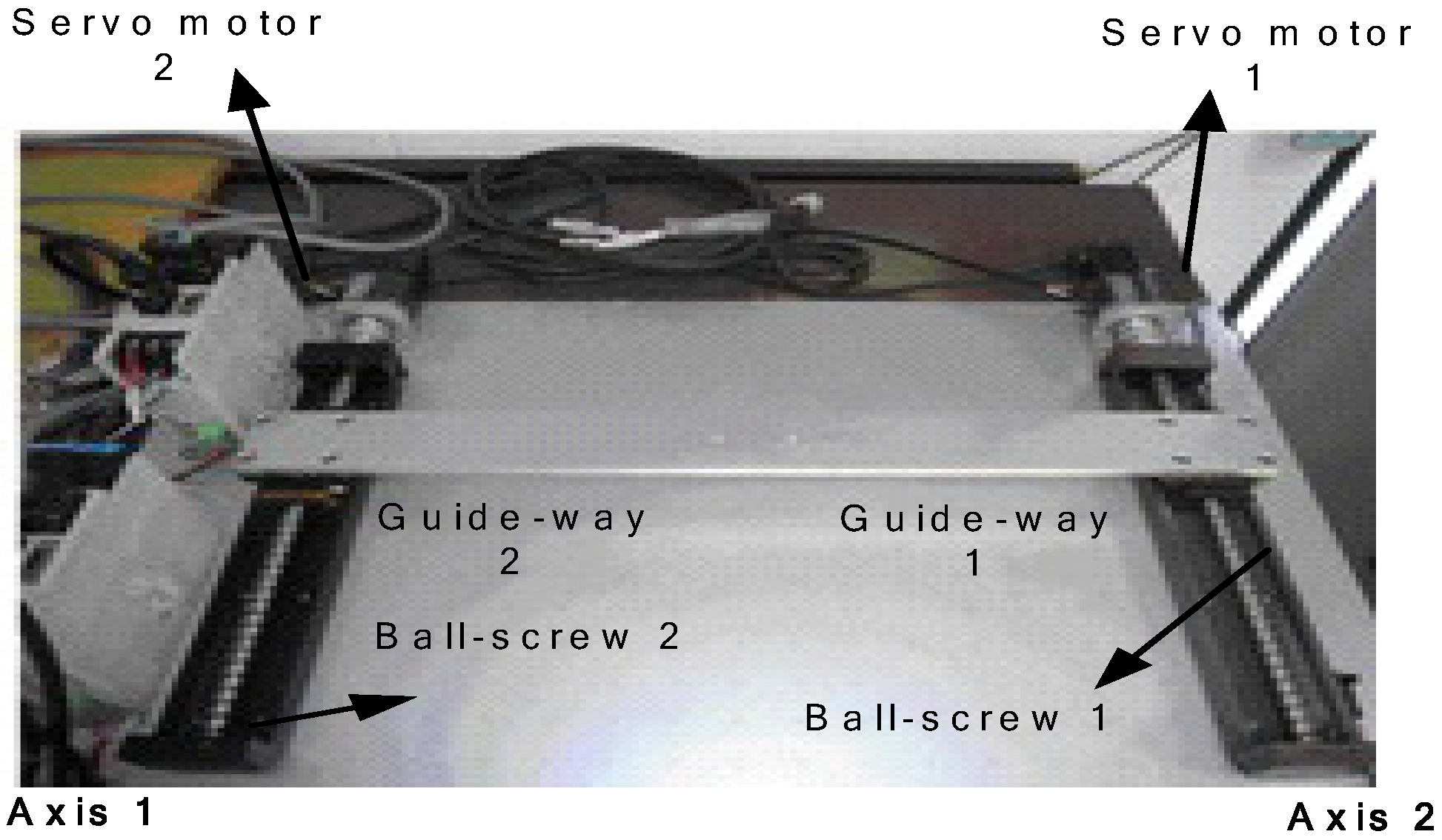
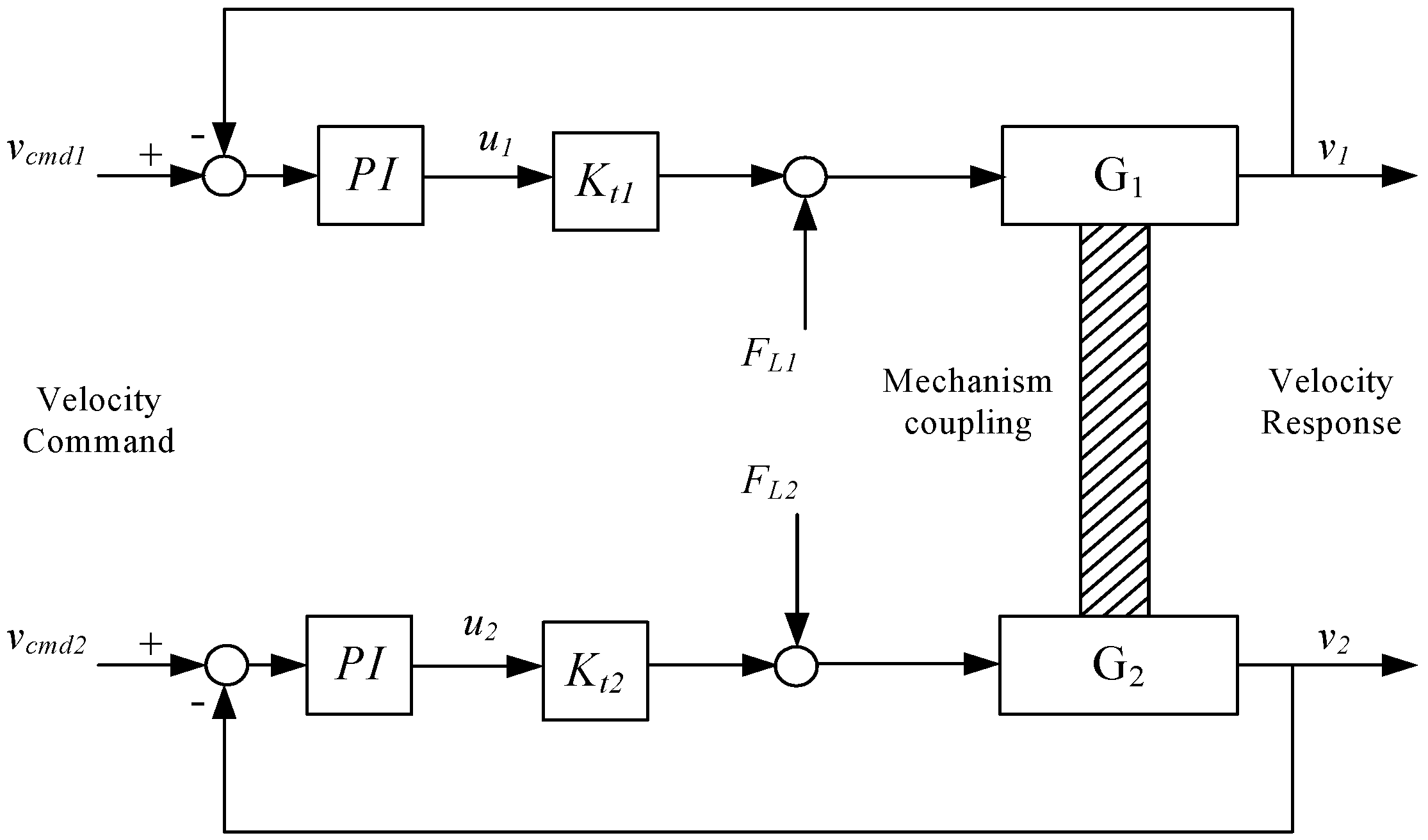
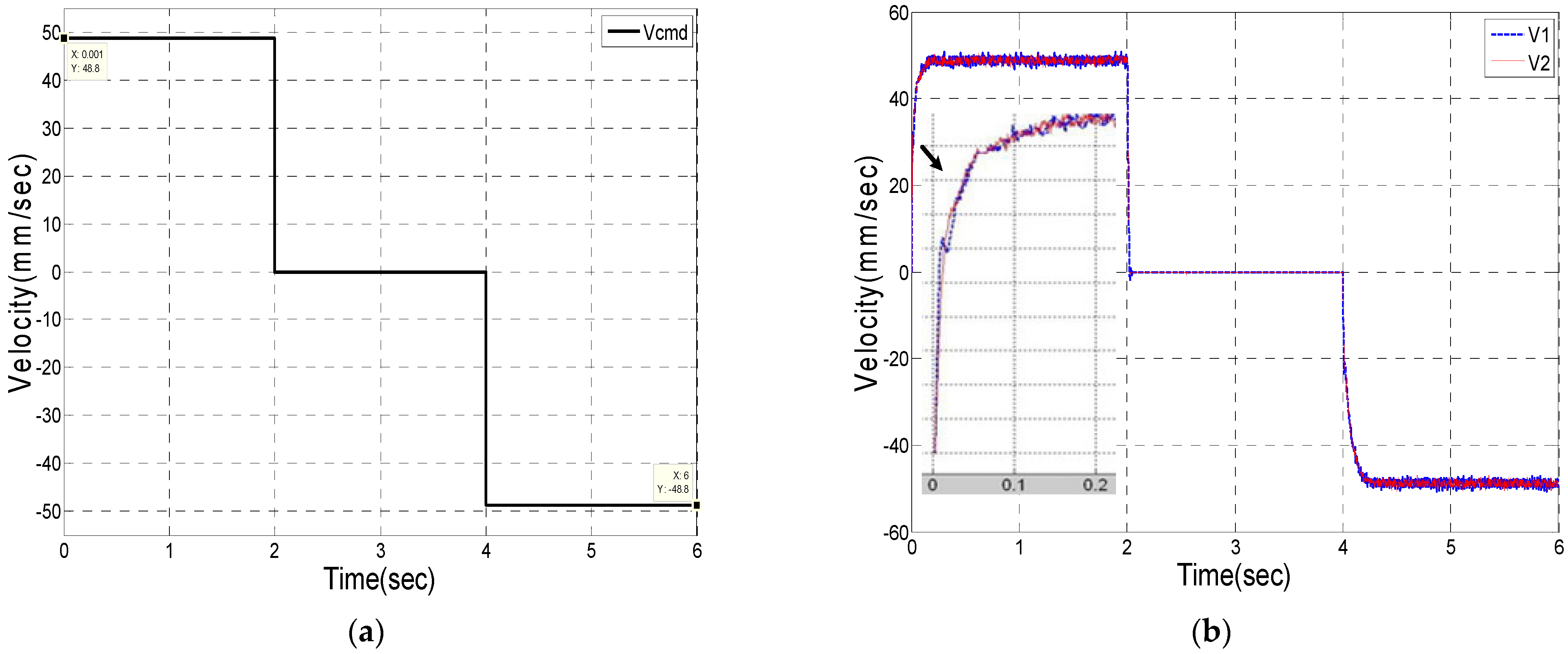
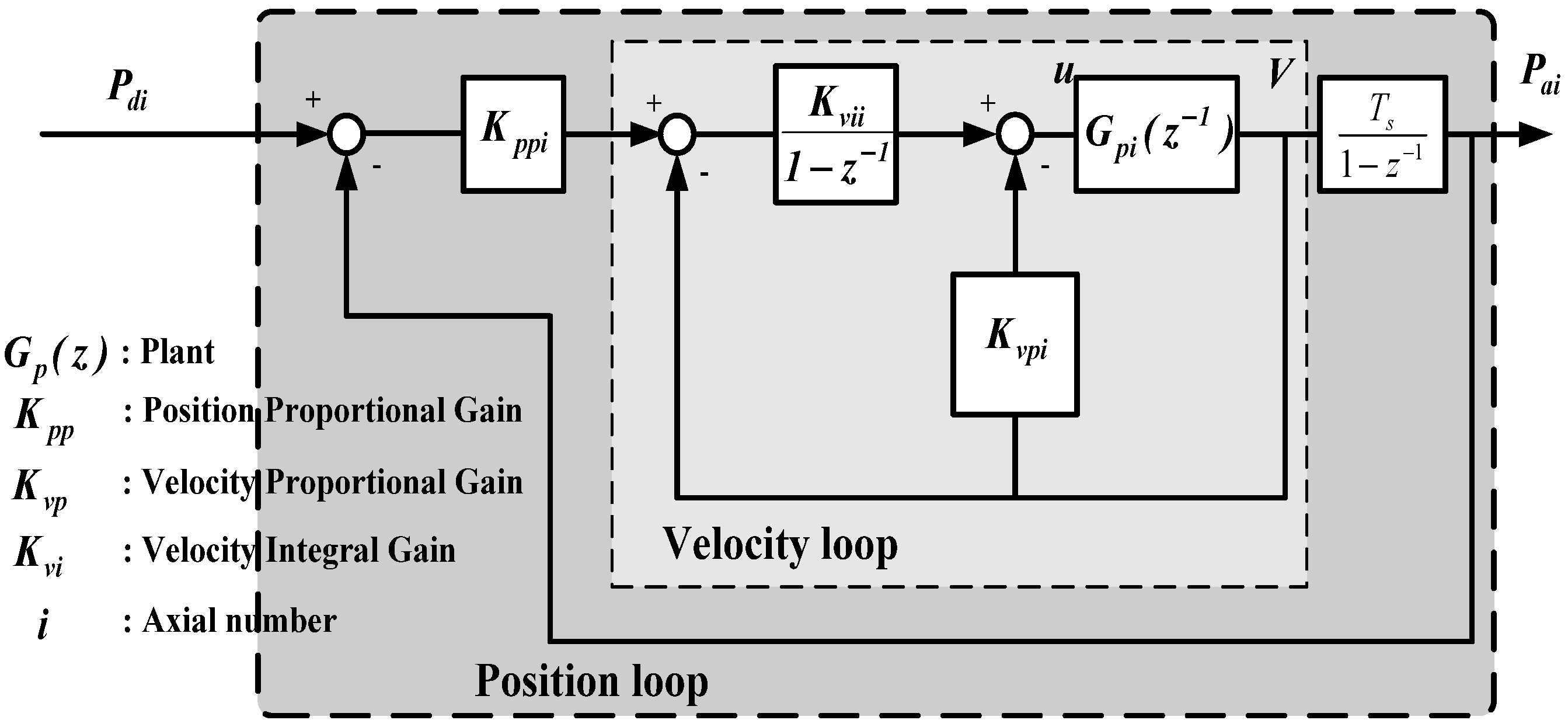
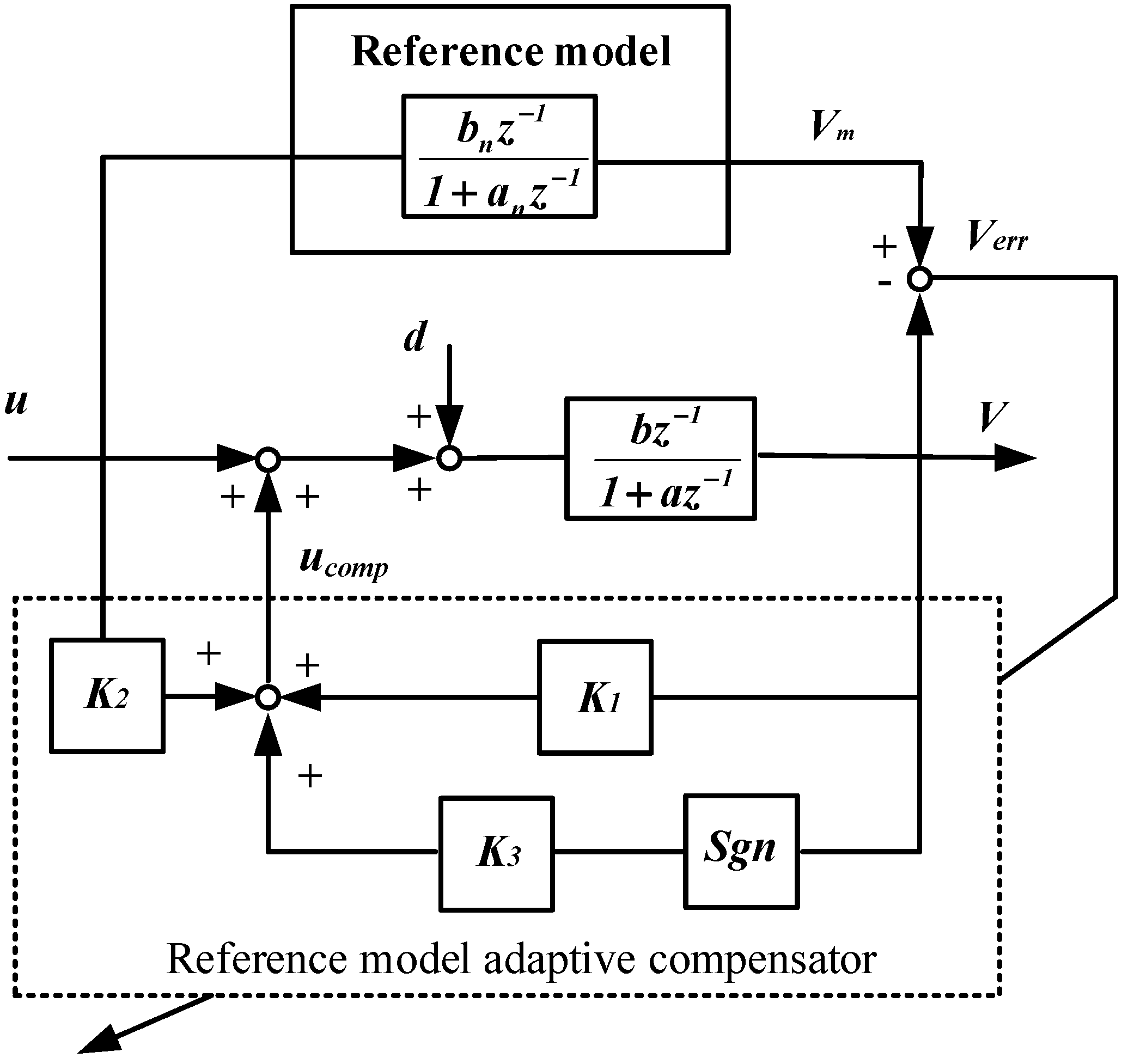
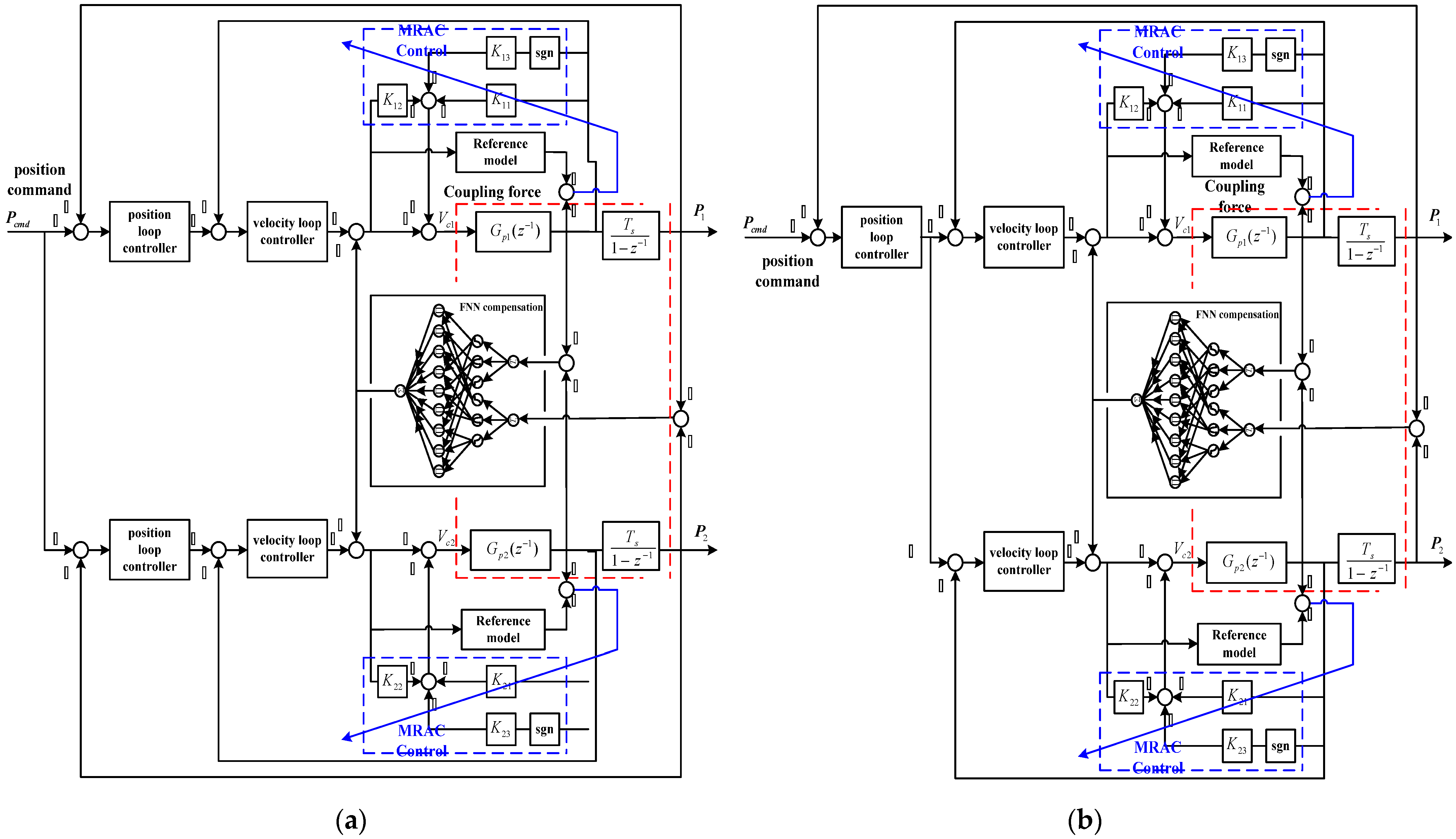
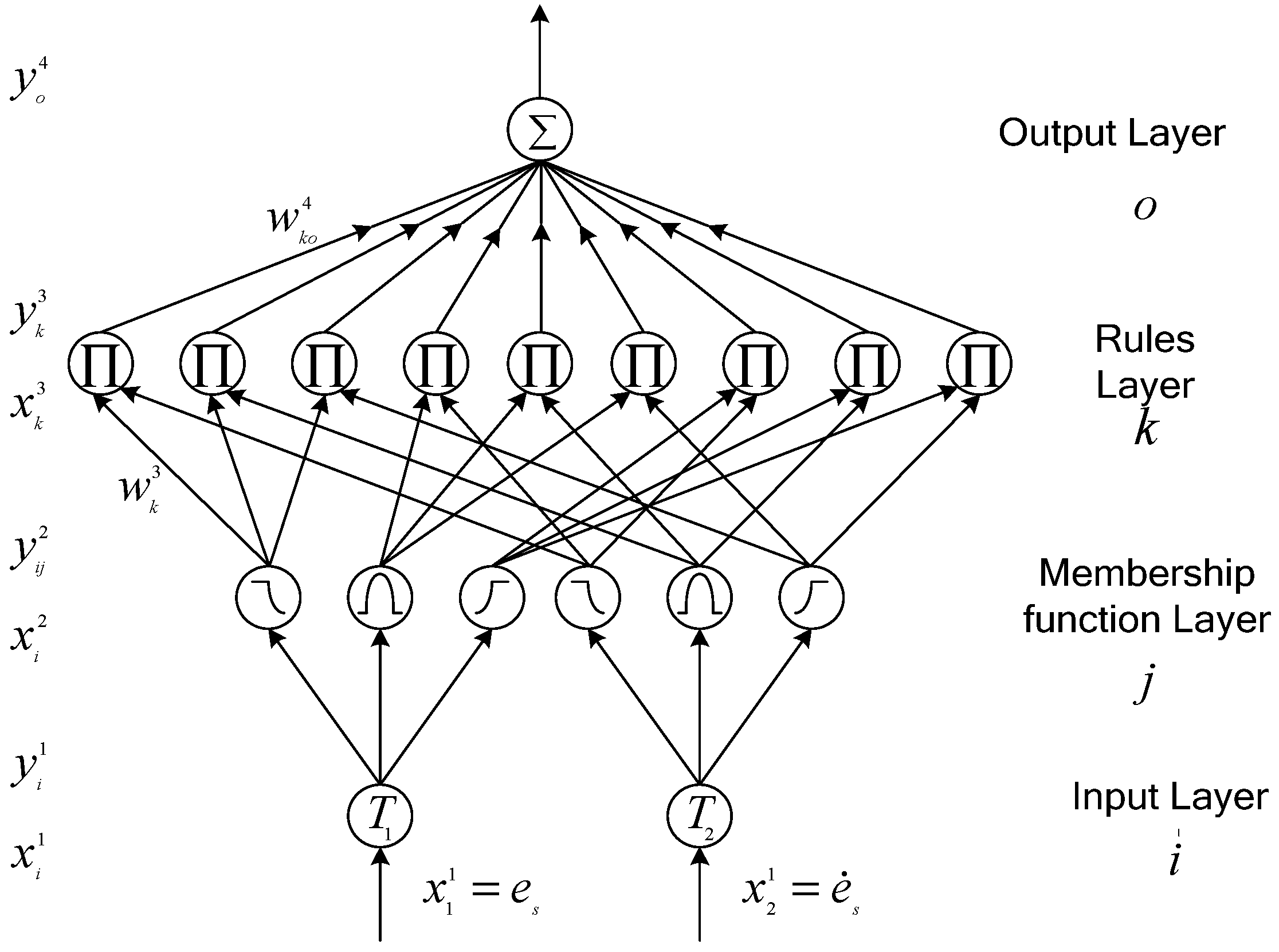



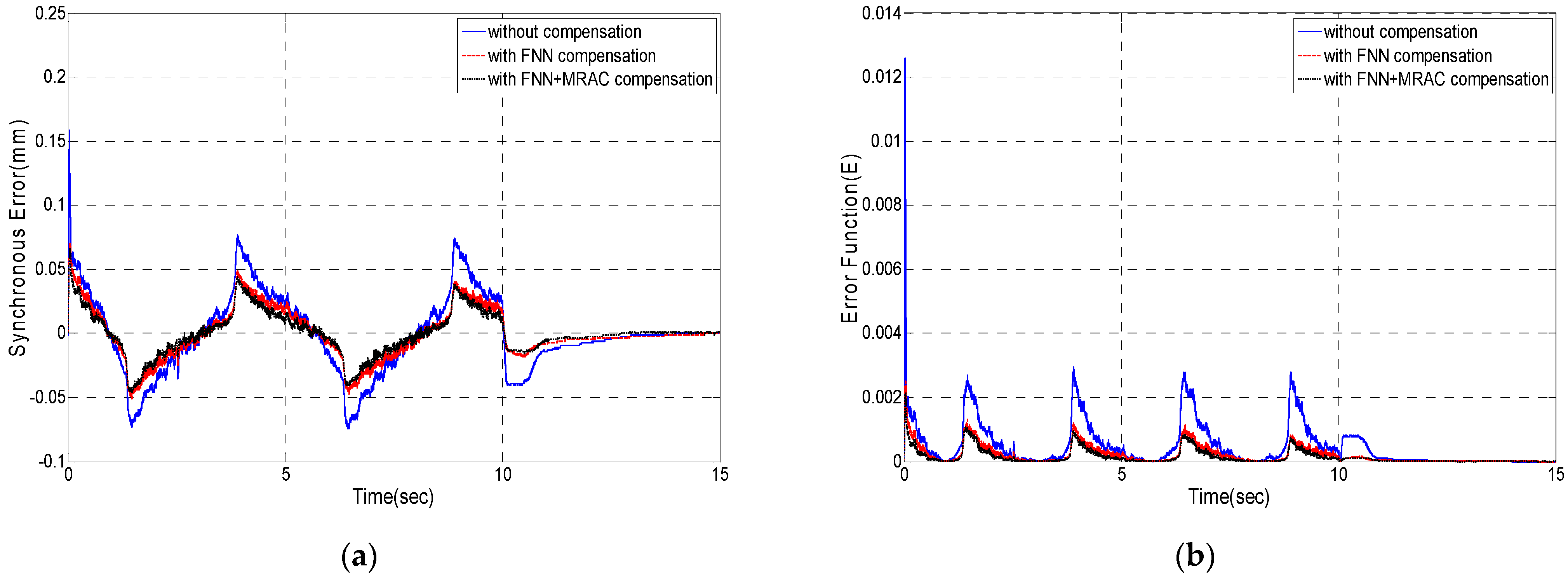

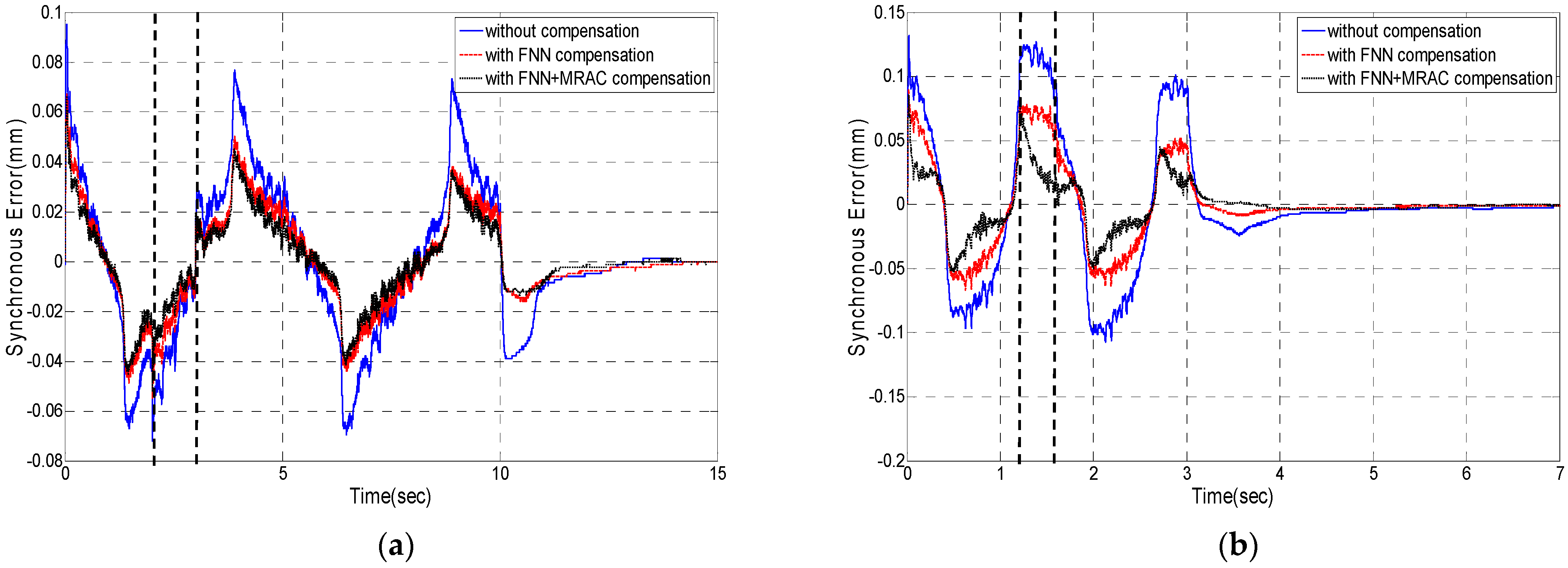
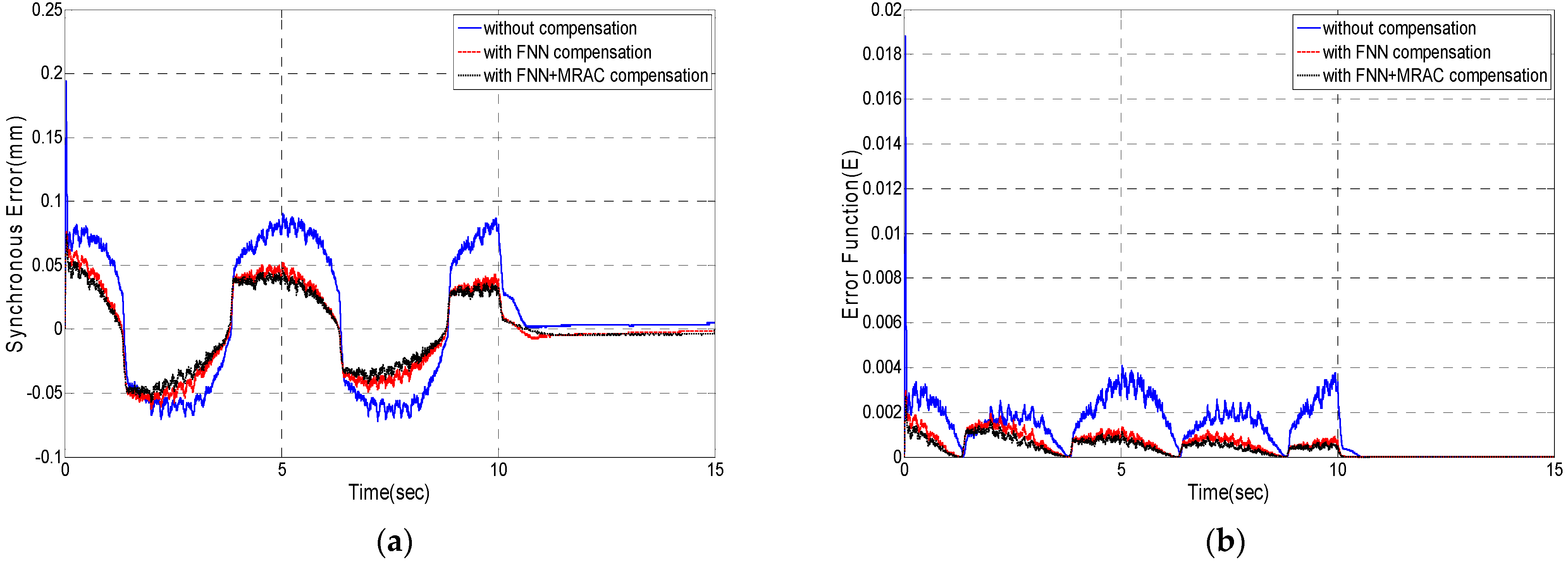


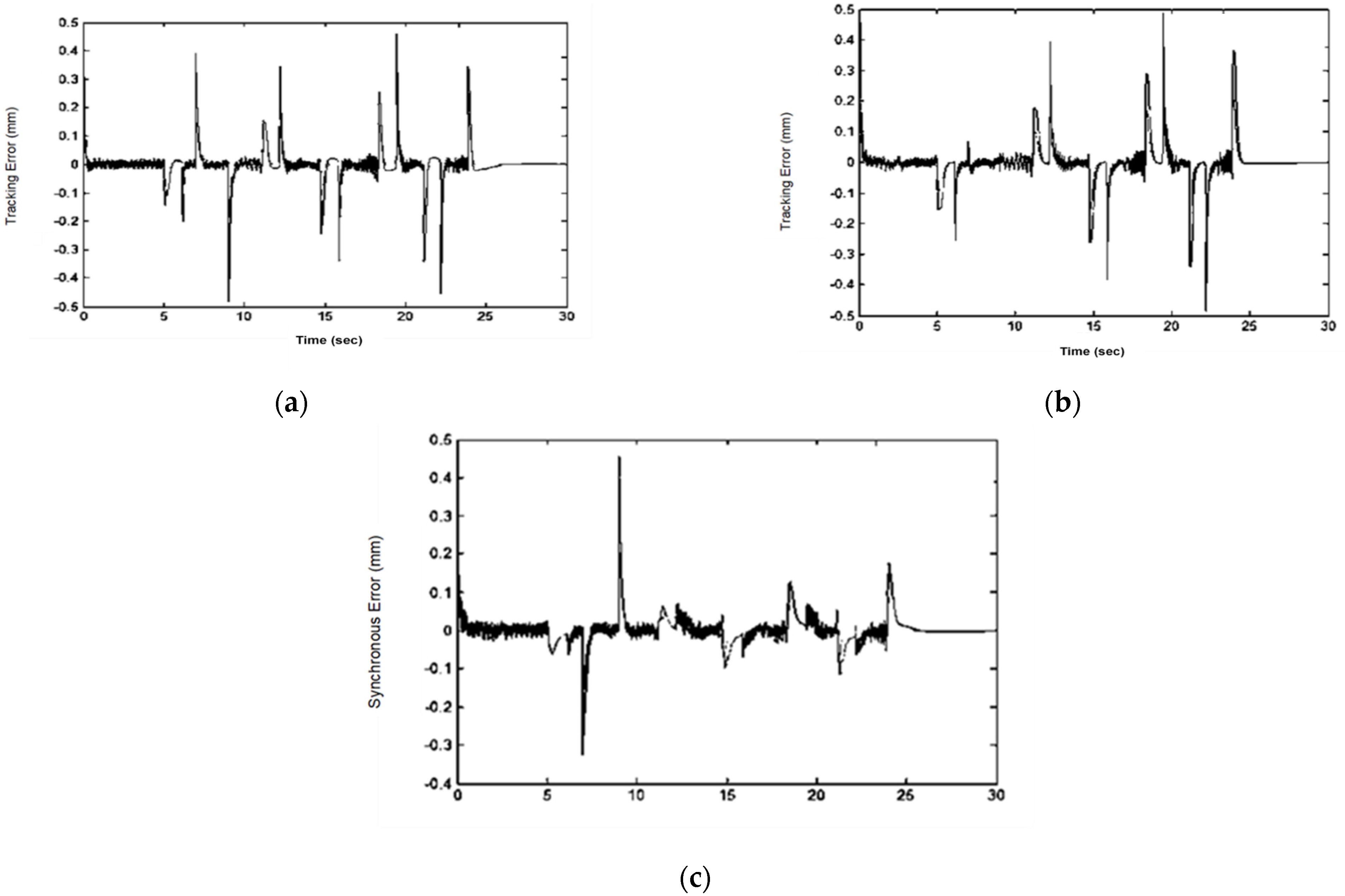
| Gain | Value | Time Constant | Value |
|---|---|---|---|
| 393.79 | 0.06 | ||
| 384.49 | 0.06 |
| Performance Index (mm) | No Compensation | FNN | FNN + MRAC | |
|---|---|---|---|---|
| without disturbances | 294.204 | 195.394 | 157.399 | |
| 0.0359 | 0.0235 | 0.0198 | ||
| with disturbances | 30.125 | 25.126 | 23.142 | |
| 0.0387 | 0.0241 | 0.0204 |
| Performance Index (mm) | No Compensation | FNN | FNN + MRAC | |
|---|---|---|---|---|
| without disturbances | 578.168 | 357.550 | 307.116 | |
| 0.0606 | 0.0383 | 0.0330 | ||
| with disturbances | 91.225 | 71.114 | 63.453 | |
| 0.0918 | 0.0709 | 0.0644 |
| Performance Index (mm) | No Compensation | FNN | FNN + MRAC | |
|---|---|---|---|---|
| without disturbances | 208.891 | 124.671 | 71.494 | |
| 0.0768 | 0.0461 | 0.0278 | ||
| with disturbances | 48.253 | 29.221 | 15.223 | |
| 0.117 | 0.0653 | 0.0341 |
| Performance Index (mm) | No Compensation | FNN | FNN + MRAC | |
|---|---|---|---|---|
| without disturbances | 262.844 | 189.101 | 129.021 | |
| 0.0914 | 0.0667 | 0.0449 | ||
| with disturbances | 52.573 | 35.891 | 26.432 | |
| 0.129 | 0.0892 | 0.0654 |
| Performance Index (mm) | No Compensation | FNN | FNN + MRAC |
|---|---|---|---|
| 0.04 | 0.024 | 0.02 |
Publisher’s Note: MDPI stays neutral with regard to jurisdictional claims in published maps and institutional affiliations. |
© 2021 by the authors. Licensee MDPI, Basel, Switzerland. This article is an open access article distributed under the terms and conditions of the Creative Commons Attribution (CC BY) license (https://creativecommons.org/licenses/by/4.0/).
Share and Cite
Chen, C.-S.; Hu, N.-T. Model Reference Adaptive Control and Fuzzy Neural Network Synchronous Motion Compensator for Gantry Robots. Energies 2022, 15, 123. https://doi.org/10.3390/en15010123
Chen C-S, Hu N-T. Model Reference Adaptive Control and Fuzzy Neural Network Synchronous Motion Compensator for Gantry Robots. Energies. 2022; 15(1):123. https://doi.org/10.3390/en15010123
Chicago/Turabian StyleChen, Chin-Sheng, and Nien-Tsu Hu. 2022. "Model Reference Adaptive Control and Fuzzy Neural Network Synchronous Motion Compensator for Gantry Robots" Energies 15, no. 1: 123. https://doi.org/10.3390/en15010123
APA StyleChen, C.-S., & Hu, N.-T. (2022). Model Reference Adaptive Control and Fuzzy Neural Network Synchronous Motion Compensator for Gantry Robots. Energies, 15(1), 123. https://doi.org/10.3390/en15010123







